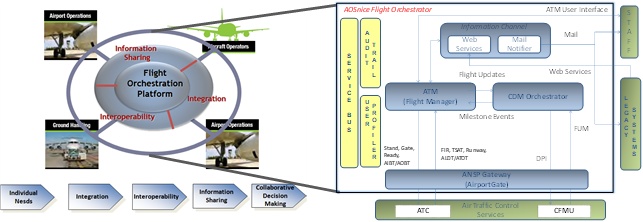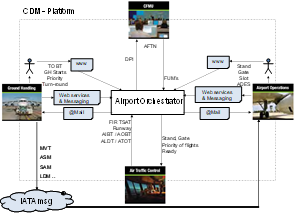OPERATIONS
COLLABORATIVE FLIGHT MANAGEMENT
Airports are extremely complex systems, being composed of several sub-systems, processes and operations, where a multifaceted network of stakeholders operates. Moreover, the large number of stakeholders involved in airport operations have different and sometimes conflicting objectives, strategies and procedures, making common decision-making a very hard task to accomplish. The interconnections among the complex network of stakeholders, indeed, create chain reactions and domino effects. This, in turn, makes facing with unexpected events very hard only considering sub‑systems and operations as isolate agents. Aircraft delays and resource unavailability are only part of the unpredictable events that are becoming more and more common in today’s airport environment. The increasing rate of such events is directly linked to the exponential growth of air traffic at a global level, and the willing of airlines to reduce as much as possible turnaround times.
In this context, resource allocation and optimization have become crucial tasks to face with to ensure high level of service to passengers and efficient airport operations. EUROCONTROL recommends the concept of Airport-Collaborative Decision Making (A-CDM) to enable the turnaround optimization process. The underlying idea of A-CDM is to improve the stakeholders awareness through data sharing and data quality. Nevertheless, no support in coordination is provided and actions are undertaken from a single stakeholder without any level of harmonization.
The introduction of Airport-CDM represents a drastic change to existing airport operational processes, culture and knowledge sharing behaviours in order to deliver high level of collaboration among airport stakeholders, improve forward planning and decision-making, and maximize airport and aerospace capacity.
Software Design enriched the AOSnice portfolio with Airport-CDM solutions referred as Collaborative Flight Orchestration. Such solutions have been designed to go beyond CDM needs creating an innovative collaboration environment involving human operators and automatic systems belonging to the several stakeholders.
Flight orchestration solutions will help in removing the bottleneck in the airspace optimization process represented by airport operations unpredictability empowering ground handling agents and airport authorities.
Collaborative Flight Orchestrator is mainly a complex event processing and real-time information management solution that allows airports to aggregate all available data sources maintaining an accurate real-time view of flights and related infrastructure in whole coordinated processes. As a result, exploiting Collaborative Flight Management facilities, Airport processes can be layered integrating in a whole workflow all stakeholder processes exchanging relevant data about resources and flights in real time through loose coupling technologies. So doing, hard tasks such as flight management and resource planning will be driven by airport level events.
Collaborative Flight Management suite is composed of the following main modules:
- Airport Traffic Manager managing flight movements, infrastructural resources and flight loads.
- Ramp Monitor representing a high value support for any airport operator giving a very impressive graphical interactive view of the ramp showing ongoing flights and associated services status.
- XMessage managing all messages received with a virtual teletype approach.
- ApocDashboards, representing a Light solution to monitor airport performances
- CDM Orchestrator, aimed at managing flights status, resources and related events in a comprehensive and process based on workflow milestones.
- ANSP Gateway, which manages Airport Traffic Control systems by means of several available interfaces.
The designed APOC Light represents a starting point for immediate implementation that allows future evolutions and additions. APOC Dashboard. It is equipped with four operational views that allow you to have the situation under control in real time by comparing what has happened with what is forecasted :

- Real Time SLA: allows you to monitor the real-time status of operational performance and the occupancy status of infrastructure resources
- Occupancy status of the stands with indication of the flights scheduled or currently parked on them and the status of the flights themselves
- Resulting SLAs from the previous day
- Flight and departing passengers trends: number of passengers expected versus actual curve distinguished between shengen and extra-shengen, number of PRM passengers booked, timeline of occupation of stands with flight status, weather data
The power of Collaborative Flight Management tools leverage on some AOSnice basic modules enforcing the impact of results through advanced security and interoperability capabilities :
- User Manager managing stakeholders and legacy systems enrollements
- Airport Service Bus allowing a loose coupled interaction among cooperating modules through subscribing and notify policies
- Audit Trail allowing storing of relevant actions carried out by any involved actor and related browsing functionalities
Moreover, AOSnice portfolio makes available Resource Planning solutions which can simplify Flight Orchestration challanges for airport authorities and handling agents :
- ResourceBrain-Human&Mobile devoted to planning and management of Human and mobile resources
- ResourceBrain-Fixed aimed at planning and managing all Airport Facilities such as stands, checkin-desks, gates, etc.
Software Design’s Collaborative Flight Management solution inherits all the technical and technological characteristics of the integrated framework AOSNice which it is part of :
- web compliant 3-tier architecture
- airport service bus interoperability based on JMS technology
- Jbpm business process management services
Flight Orchestrator provides a single, common information sharing framework for all airport partners, capable of orchestrating the overall Airport collaboration starting from individual local needs up to the integration, information sharing and interoperability.
Airport Orchestrator Platform is composed of dedicated CDM Orchestration modules and native AOSnice integration capabilities.

The Airport Orchestrator is based on following principles:
- Airport Orchestrator can operate in a native mode with other AOSnice resource planning solutions to fulfill all CDM targets in a whole
- Completely scalable to be suitable for all airport sizes and complexities
- Completely modular, based on distributed architecture to save as much as possible roles and infrastructure ownership
- CDM Orchestrator is mainly based on workflow of data coming from all stakeholders and generation of well standardized derived data
- The core software can be customized according to local requirements, including the interfaces with existing systems. It can be implemented as a standalone system, or integrated with existing systems, or a combination of both.
- Makes available both standard system interfaces to legacy applications owned by stakeholders and human data entry : Web interface to insert/update data in charge at each airport operator, Mail notifications including both a human readable section and an XML formatted section, JMS messaging, Specialized web services to support a loose coupled integration with legacy systems .

In order to gain a clear view on how the coordination role of the Airport Orchestrator can take place, here follows a use case for an orchestrated flight delay occurrence :
- Aircraft Operator sends a new EIBT to the Airport Orchestrator which dispatch the event to all registered clients
- Airport Operator receives the change and activates STANDS and CONVEYORS planning based on their own RMS rules
- New resource allocations are received by the Airport Orchestrator and dispatched
- Handling Agents receives changes and activate replanning of Human Resources and GSE based on own RMS rules. Eventually, new TOBT generated are sent to the Orchestration Kernel which dispatches the event
- Airport Operator receives the TOBT, activates STANDS, GATES and FINGERS planning based on their own RMS rules
- New resource allocations are received by the Airport Orchestrator and dispatched
- ATC receives new TOBT and generate new TSAT sent to the Airport Orchestrator which dispatch the event
- Handling Agents receive new TSAT and in the case activate a new re-planning which in turn start a new cycle.





